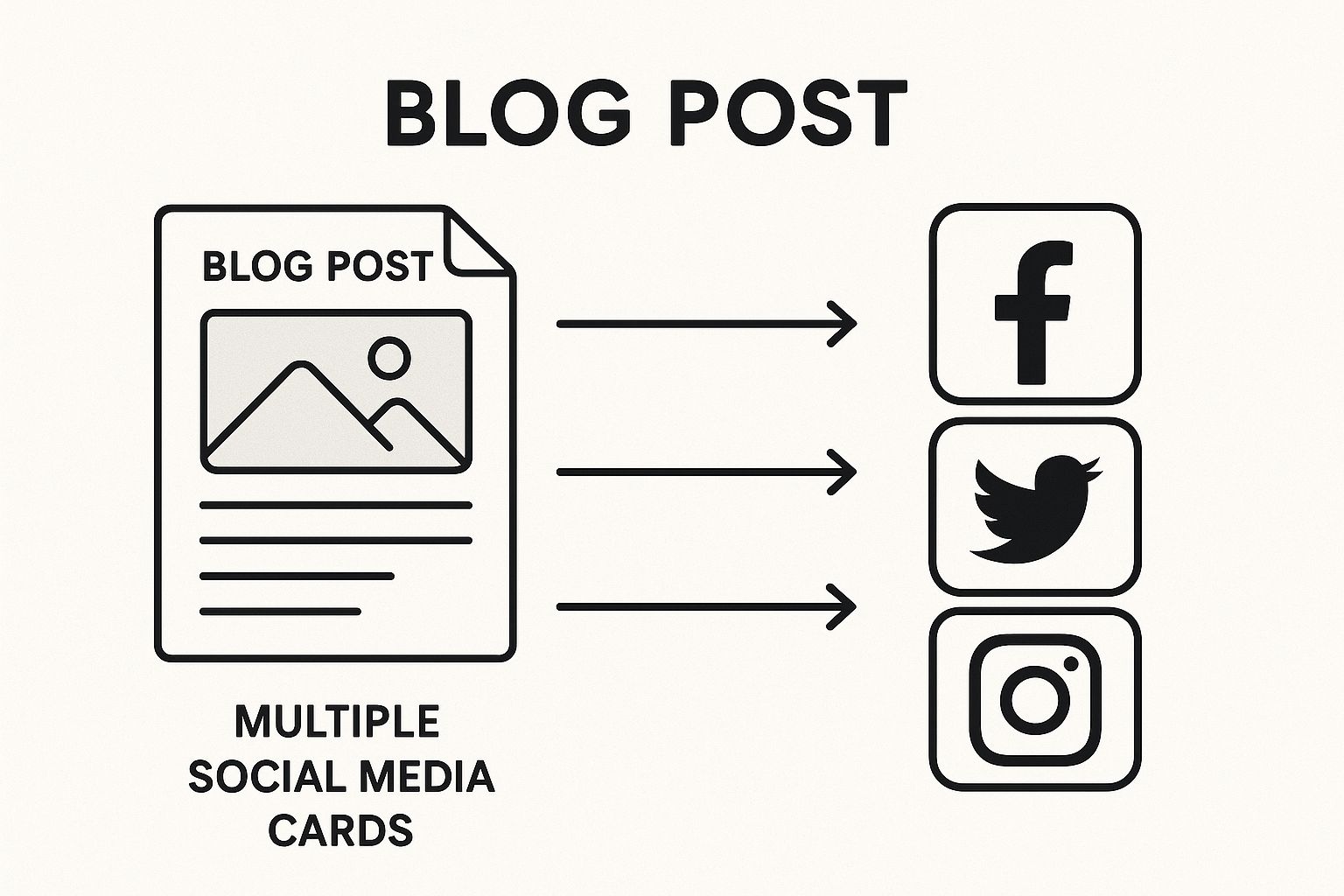How to Repurpose Content: Turn One Idea into Many Wins

The Art and Science of Content Repurposing

Creating top-notch content consistently takes serious time and effort. This is where content repurposing shines, turning this challenge into a major advantage. Instead of constantly reinventing the wheel, content repurposing lets you strategically stretch the lifespan and reach of your already successful content.
This is more than just reposting old stuff; it's about thoughtfully adapting and transforming content to connect with different audiences on various platforms.
Why Repurpose Content?
Top brands are increasingly shifting resources toward content transformation instead of constant creation. Imagine a successful blog post, for example. The core message and research within it can be incredibly valuable in several other formats. This allows for deeper audience engagement across multiple channels while maximizing ROI (Return on Investment). Think of it like a versatile actor playing different roles in various productions, captivating a new audience each time.
Content repurposing also taps into the psychology of varied learning styles. People absorb information differently. Some prefer reading blog posts, others gravitate towards visuals like infographics or videos. By presenting the same core message in multiple formats, you cater to these different preferences and expand your potential audience.
This strategic approach is vital in today's content-saturated world. In 2025, content repurposing is especially critical. 46% of marketers believe that recycling existing content is more effective than starting from scratch. This helps businesses reach a broader audience and reduce content creation costs. Original research reports and surveys are particularly valuable for repurposing. They can become blog posts, social media graphics, or even video scripts, boosting credibility and trust while increasing audience engagement across platforms. For a deeper dive into content repurposing statistics, find more detailed information here.
Repurposing: Beyond Simple Recycling
True content repurposing is more than just hitting the repost button. It's about understanding how to effectively transform your content to fit the specific needs of each platform. This means analyzing your existing content, identifying its strengths, and getting creative to reimagine it for different mediums.
This might look like:
- Content Expansion: Taking a short blog post and turning it into a comprehensive whitepaper or ebook.
- Content Distillation: Condensing a lengthy research report into digestible social media posts or infographics.
- Content Reimagination: Transforming a customer testimonial into a compelling video or animated explainer.
By mastering content repurposing, you amplify your message, reach new audiences, and maximize the impact of your existing content. This frees up valuable time and resources, allowing you to focus on creating truly fresh content that drives business growth.
Spotting Gold in Your Content Archive
Not all content performs equally. Some pieces resonate with your audience, driving traffic and engagement, while others fade into obscurity. Understanding how to effectively repurpose content begins with selecting the right pieces to revive. Successful content teams don't choose articles at random; they strategically evaluate their archives for hidden gems. This requires a shift from simply checking pageviews to a more nuanced understanding of content performance.
Identifying High-Potential Content
Engagement metrics offer a richer picture than traffic numbers alone. A blog post with a high average time on page, for instance, suggests readers find the content valuable and are actively engaging with the information. Similarly, a significant number of social shares indicates the content resonates and has the potential to reach a broader audience across various platforms. Want to learn more about expanding your reach? Check out this resource: How to master your LinkedIn presence.
Furthermore, comment sections can be a treasure trove of information. Look for comments that prompt further questions, initiate discussions, or express interest in more detail on a specific topic. This direct audience feedback provides valuable clues about engaging content and topics worth exploring further.
Differentiating Between Content Quality and Format
It's important to differentiate between content that underperformed due to quality issues and content that simply requires a different format or platform. A well-researched whitepaper, for example, might not gain much traction in its original form but could be very successful repurposed as a series of social media posts, short videos, or even an infographic.
A Data-Driven Approach to Content Selection
A structured evaluation process is key to identifying high-potential content. The following table provides a framework for assessing which content pieces are most suitable for repurposing efforts.
To help illustrate this process, let's look at some key criteria for assessment:
Content Repurposing Potential Assessment Criteria A framework for evaluating which content pieces are most suitable for repurposing efforts
| Assessment Criteria | High Potential Indicators | Low Potential Indicators |
|---|---|---|
| Engagement | High average time on page, many social shares, active comments | Low average time on page, few social shares, no comments |
| Relevance | Evergreen topic, still relevant to current audience needs | Outdated information, no longer relevant to target audience |
| Shareability | Easily adaptable to different formats and platforms | Difficult to translate to other mediums |
| SEO Performance | Strong keyword rankings, consistent traffic | Poor keyword rankings, declining traffic |
This table highlights the key indicators to look for when evaluating content for repurposing. High engagement, relevance, shareability, and strong SEO performance are all positive signs.
Content marketing budgets are on the rise, with 46% of B2B marketers anticipating a budget increase in 2025. This underscores the growing importance of strategies like content repurposing to maximize existing assets. Learn more about these trends: Explore this topic further. Repurposing allows companies to enhance their online presence and search rankings by reformatting existing content for various channels. For more in-depth strategies, consider exploring additional resources on content repurposing strategies. By analyzing these factors, you can effectively identify valuable content within your archive and determine which pieces deserve repurposing efforts. This data-driven approach maximizes the chances of success for your repurposed content.
Transformational Techniques That Actually Work

The infographic above shows how one blog post can become many social media cards. This demonstrates the core idea of content repurposing. This visual reminds us that repurposing isn't copying, it's adapting your message for different formats. This helps your content find a bigger audience and keeps your brand consistent.
Repurposing is more than just format changes. It's about making existing content fresh and engaging. This strategic approach maximizes the value of your best work. Leading brands are getting great at this. They're getting the most from their content marketing. A data-heavy whitepaper, for example, can become engaging social media posts. A customer interview can transform into a video series.
Format-Specific Transformation Frameworks
Several techniques help with successful repurposing. Each keeps your core message while making it work on different platforms.
Content Expansion: Turn a short piece, like a blog post, into something bigger, like an ebook or whitepaper. This lets you dive deeper into a topic, giving your audience more.
Content Distillation: The opposite of expansion. Take a long piece and make it shorter. Think social media posts, infographics, or short videos. This is great for sharing key takeaways.
Content Reimagination: Transform existing content into something totally new. A customer testimonial could become a video or animation. Interested in more ideas? Check out: 10 proven content repurposing strategies to boost ROI. This gives old content new life and reaches new people.
To help illustrate the different transformations, let's look at the following table:
Content Format Transformation Matrix: A comprehensive guide showing how different original content types can be transformed into various formats.
| Original Format | Potential Transformations | Effort Level | Typical ROI |
|---|---|---|---|
| Blog Post | Social Media Posts, Infographic, Short Video, eBook, Whitepaper | Low to Medium | High |
| Whitepaper | Series of Blog Posts, Social Media Posts, Infographic, Presentation | Medium | Medium |
| Customer Interview | Video Testimonial, Blog Post, Case Study, Quote Graphic | Medium to High | High |
| Webinar | YouTube Video, Blog Post Series, Podcast Episode, Social Media Snippets | Low to Medium | Medium |
This table shows how versatile different content formats can be. A single piece, like a blog post, can be transformed into numerous high-value assets, leading to a significant return on investment. By understanding these potential transformations, businesses can strategically plan their content creation and maximize their reach.
Leveraging AI in Content Repurposing
AI use in content repurposing is increasing. In 2025, AI tools are important for businesses. They quickly transform content, saving time and money. This helps companies connect with different audiences and improve SEO. AI also keeps messaging consistent, which strengthens your brand. These tools use data to analyze performance and suggest improvements. Explore this topic further: Learn more about AI in content creation.
Practical Approaches and Examples
If you have well-performing content, explore top content repurposing strategies. Imagine a blog post about product benefits. You could expand it into a detailed guide. You could distill it into social media posts highlighting key benefits. Or you could reimagine it as a short video.
By using these techniques, you can boost your content's reach and impact. This creates a cycle where your best content keeps working for you on many platforms.
Platform-Perfect Adaptation Strategies

Simply reposting the same content across all platforms won't yield the desired results. Each platform possesses its own unique culture and algorithms. Successful brands recognize this and adapt their repurposed content accordingly. This involves understanding how to reshape your core message to resonate with LinkedIn's professional audience just as effectively as it does with TikTok's entertainment-focused users.
Understanding Platform Nuances
Think of each platform as a unique environment. While the underlying language (your core message) remains consistent, the style and customs vary. A formal presentation that excels on LinkedIn might not perform well on Instagram, where visuals and short, engaging captions are paramount. Similarly, a short, witty TikTok video probably won't translate effectively into a long-form LinkedIn article.
Tailoring Content for Specific Platforms
This means understanding the optimal content length, format, and what captures attention on each platform. For instance, LinkedIn favors in-depth articles and professional insights. Brevity is crucial on Twitter, where concise, impactful messaging flourishes. Instagram and TikTok prioritize visually engaging content like images, videos, and stories. A blog post about leadership could be transformed into a series of LinkedIn articles offering career advice. That same blog post could also become short, engaging videos for TikTok, providing quick leadership tips. You might be interested in: How to master LinkedIn for business growth.
Preserving Your Core Message Across Platforms
The objective is to maintain a consistent brand voice while adapting to the style of each platform. This ensures your repurposed content feels authentic and purposeful, not forced. Consider a case study about a successful marketing campaign. It could become a detailed LinkedIn article showcasing the strategy's effectiveness. The same case study could be condensed into an Instagram carousel highlighting key results with compelling visuals. This approach keeps your brand strong and recognizable regardless of the platform.
Practical Examples of Cross-Platform Content
Imagine you're hosting a webinar on financial planning. For LinkedIn, share key takeaways as a text-based post or short video geared towards professionals. On Instagram, create visually appealing infographics or quote cards highlighting important financial tips. On YouTube, upload the full webinar recording for a comprehensive overview. Each piece serves a distinct purpose yet promotes the same core message.
By strategically adapting your content, you ensure your message connects with the appropriate audience in the most effective manner. This maximizes your reach and strengthens the impact of your content repurposing initiatives.
Building Your Content Transformation Machine
Repurposing content successfully isn't a matter of haphazardly recycling old material. It takes a systematic and strategic approach. Top-performing content teams grasp this, implementing efficient and sustainable workflows that amplify their reach without compromising quality. Repurposing isn't a last-minute addition; it's a core element of their content strategy.
Integrating Repurposing into Your Workflow
Instead of viewing repurposing as a separate task, think about weaving it directly into your existing content creation process. For instance, while planning a new blog post, simultaneously brainstorm its potential transformations. Could key takeaways be condensed into a short, engaging video for social media platforms like Instagram? Might the data and statistics within the post be visualized as an informative infographic? This proactive approach simplifies the repurposing process and ensures you extract maximum value from every piece of content.
This forward-thinking strategy not only streamlines the repurposing process but also encourages a more holistic view of content creation from the outset.
Team Structures That Facilitate Repurposing
The way your content team is structured can significantly impact your repurposing success. A dedicated repurposing specialist, focused solely on transforming existing content into new formats, can ensure quality and consistency across all platforms. This dedicated role maintains a cohesive brand voice and message regardless of the content's format.
Alternatively, repurposing responsibilities can be distributed among existing team members, capitalizing on their individual skills and strengths. A skilled writer could adapt blog posts into compelling LinkedIn articles, while a graphic designer might transform complex data into visually appealing infographics. This collaborative approach leverages the expertise within your team.
Technology Stacks That Accelerate Transformation
A variety of tools exist to streamline the often complex process of repurposing. Lumeo, for instance, allows users to transform existing content into engaging, dynamic carousel presentations suitable for various social media platforms. Other tools offer automated social media scheduling and content formatting features. These tools empower teams to quickly and easily adapt content for different audiences, saving valuable time and resources.
By automating these tasks, teams can dedicate more time to crafting high-quality, original content.
Quality Control for Repurposed Content
Maintaining high quality across all content formats is paramount. This requires well-defined quality control processes. Before publishing any repurposed content, rigorously review it to ensure it adheres to the same standards as your original work. Check for accuracy, clarity, and alignment with your brand voice and style guide.
This meticulous attention to detail ensures your repurposed content strengthens, rather than diminishes, your brand's reputation.
Overcoming Common Bottlenecks
Several common obstacles can impede repurposing efforts. One is the lack of a clear strategy. Define specific, measurable goals for your repurposed content. Is the primary objective to boost brand awareness, drive traffic to your website, or generate leads? A clearly defined strategy keeps your repurposing efforts focused and effective, maximizing their impact.
Another frequent challenge is simply finding the time. By integrating repurposing into your existing workflow and utilizing technology, you can overcome this hurdle. This integration makes content transformation a seamless part of your content lifecycle.
Measuring What Matters in Repurposed Content
How do you know if your repurposing efforts are actually making a difference? This section goes beyond vanity metrics like pageviews and explores the key performance indicators (KPIs) that truly signify successful repurposed content. This means understanding how to gauge success across different platforms and formats, and figuring out which content transformations deliver the best return on investment (ROI).
Comparing Original vs. Repurposed Content Performance
A vital aspect of measuring repurposed content involves comparing its performance to the original piece. It's important to remember this isn't a straightforward comparison. Different formats serve different purposes. A blog post might drive substantial website traffic, while an infographic repurposed from that same blog post could boost social media engagement. Both are valuable, but measured differently.
Attribution models can help untangle these contributions. For instance, if a LinkedIn post linking back to your original blog post leads to a spike in website traffic, an attribution model can assign credit to that LinkedIn post. This highlights which repurposed formats are most effective in driving traffic back to your core content hub.
Benchmarking for Different Content Types and Platforms
Setting realistic performance expectations for repurposed content requires understanding typical benchmarks across different formats and platforms. A short TikTok video might aim for high view counts, while a longer YouTube webinar recording might prioritize watch time and audience retention. These benchmarks provide context for evaluating whether your repurposed content is achieving its goals on the intended platform.
Advanced Tracking Techniques for Deeper Insights
Beyond basic metrics, advanced tracking techniques offer deeper insights into audience engagement. Tracking click-through rates on links within a repurposed Instagram Story can reveal which calls to action resonate most. Analyzing comments and questions on a repurposed LinkedIn article helps shape future content and refine messaging.
This qualitative data goes beyond simple numbers, revealing how your audience interacts with the content and what truly resonates. This information is crucial for optimizing your content strategy and maximizing the impact of your repurposing efforts.
By grasping the nuances of platform-specific metrics and using advanced tracking tools, you gain a granular understanding of how each repurposed piece contributes to your overall content marketing goals. This enables continuous improvement and ensures you're getting the most from every piece of content you create. Want to create captivating visual presentations from your existing content? Discover Lumeo and unlock the power of carousel presentations for your brand.